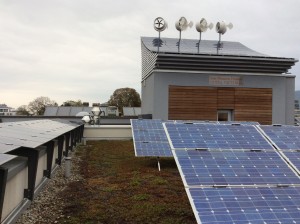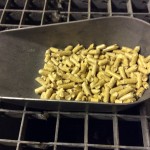I’m writing from the lobby of our hotel, where there’s a jazz combo playing in the lounge on the other side of the wall, celebrating the 140th anniversary of the Victoria’s founding, and the 30th anniversary of the current owners’ proprietorship. We aren’t attending the fancy dress party, but I’m happy to be taking advantage of the great music.

Photo-voltaic cells, wind turbines, and water heating cylinders on the roof of the Hotel Victoria (Dostal)
This morning, we had the opportunity to get a behind-the-scenes look at greening improvements made by the owners to the Victoria, making it a carbon neutral hotel. “It’s interesting that the hotel doesn’t seem any different when you walk in. There’s nothing that requires effort on the part of the guest” said Annika, in comparison to our previous conversations at Innovation Academy about making sure constituents understand and engage with technologies and practices comfortably.
We climbed to the roof to view the solar panels and tiny wind turbines, then trekked to the cellar to see the wood pellet burning heating system.
Our other guest commentator, Catherine, said that “this trip has made me realize the creative ways people are harnessing technologies that don’t occur to me, in ways that aren’t much harder than what we’re already doing.” Professor Don Barber was also able to share that some of the same cooling technology here is used at a Haverford athletic facility, which students will be able to visit on our return.
Our next tour was of Riesenfeld, which Catherine described as “a responsible community.” Once the open collection ground for the city’s sewer systems, the land was was intentionally reformed, “from the design contests about how it was going to be laid out, to all the different ways the architects made the structures energy efficient.” Annika notes that “it’s also important that there was a competition – it was digging into the skills that architects had to make it green. It was an important publicity element.” From four-story apartment buildings to single family homes, everything in the development has solar panels, insulated walls, and other eco-design features. There are green spaces, creeks, and many many playgrounds between rows of houses, all with pedestrian zoned walkways and bike storage sheds.
Catherine wondered about the circumstances that arose to allow such a project, though, and whether they are applicable elsewhere: “That takes a lot of time and effort, and a specific way of thinking about how to build a community and systems that will allow that kind of thought and intention [to living sustainable].” Annika also picked up on an interesting parallel, that “this region that focuses on sustainability also focuses a lot on children and childhood education in general, and specifically on sustainable practices, even though the population of Germany is aging.” Riesenfeld does have a central gymnasium (high school) and several kindergartens (primary schools) around which the housing developments are built, as well as a community center and ecumenical church right next to the tram stop. The focus is clearly on young families, who may find it less expensive to live here than closer to the city center.
Our last stop of the day was on the other side of Freiburg, at the Fraunhofer Institute for Solar Energy Systems, which is the largest solar R&D institution in Europe, and Annika’s favorite visit thus far. “I was a little upset that I’m not a natural science major or engineer today because I couldn’t contribute to their work, and I’m so excited by it.” Catherine found the visitor’s hall (where prototypes are displayed and photos are forbidden) “like being at Stark Industries, and [she] was geeking out a little bit.” We were given an overview of the kinds of projects the Fraunhofer undertakes, and the four areas of focus for their energy research: efficiency, conversion, distribution, and storage. Then our tour guide took us outside to the hydrogen fueling station, where we got to see a prototype of a zero emissions car, and Annika had some concerns.
“I was a little disappointed by the car… it looks like a normal car, but it has zero emissions, which was cool. But I feel like the issue is actually where the car parts are coming from, how they’re being manufactured, with what fossil fuels, and the impact that the car has before it’s even driven off the lot. And I asked the tour guide about it, and she was really focused on the zero emissions nature of the car. Looking at it more holistically, there’s a long way to go.”
Catherine added that “this trip is really focused on how communities do things, but what we use still has to be produced somewhere, and a lot of the production is done in an irresponsible way.”
Tomorrow morning, we leave Freiburg for St. Peter, a small mountain village about 20 km from the city, where we will sleep for the rest of our trip (though we’ll be back to visit other sites in Freiburg on Monday and Tuesday next week). I asked the students to reflect on their experiences thus far, and Annika brought up the vastness of climate change as an issue. “In class we’ve talked about problems now, and things that will occur and [the trip] has been helpful in making the issue much more accessible. Policy is implemented on national, state, and local levels, and seeing that [play out in Germany] has been more inspiring than a lot of the broader and gloomier readings we’ve done in class.” The stories we will hear in St. Peter (including our meeting tomorrow with a farmer who went out and bought a wind turbine because he was tired of waiting for the town to get one) bring that accessibility to an even more personal level, especially because Professor Bob Dostal has been living part time in the village for over a decade.
About our guest commentators:
Annika Cole is a sophomore International Studies major at Bryn Mawr College. She grew up surrounded by environmentally conscious and active adults, and was drawn to this 360 because she wanted to incorporate that education and awareness fostered in her into her curricular pursuits. As you may be able to tell, she’s having a great time on this trip, but she really loves her horse, and looks forward to riding again when we get back Stateside.
Catherine Rowen is a sophomore at Bryn Mawr College. She used to have nightmares about climate change as a kid, though she’s cooled down since then (unlike the planet!). As an archaeology major, she has been concerned that her studies focus on things that happened in the past to dead people, and was excited that this 360 gave her the opportunity to engage on these issues and a sense of what she could do as individual to make a difference. When she isn’t figuring out how to apply what she’s learning to archaeology, she’s playing cello in Blacktop, a band on campus.



